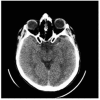Stroke Presenting as a Complication of Sarcoidosis in an Otherwise Asymptomatic Patient
- PMID: 29805931
- PMCID: PMC5969794
- DOI: 10.7759/cureus.2362
Stroke Presenting as a Complication of Sarcoidosis in an Otherwise Asymptomatic Patient
Abstract
A stroke occurring in young patients in the absence of common risk factors needs a thorough investigation of the underlying cause to prevent its recurrence. Herein, we discuss a case of stroke with rare etiology in a 28-year-old male presenting within 30 minutes of speech difficulty and right-sided weakness. The initial triage workup showed an abnormal configuration of the P wave in the 12 lead echocardiograph (ECG) and his chest x-ray (CXR) showed mediastinal widening. His echocardiogram and chest computed tomography (CT) confirmed bilateral enlargement with restrictive cardiomyopathy and mediastinal lymphadenopathy, raising a suspicion of sarcoidosis. A cardiac positron emission tomography (PET) scan confirmed the diagnosis by showing a non-caseating granuloma. The patient was put on intravenous (IV) tissue plasminogen activator (TPA) and his National Institute of Health Stroke Scale (NIHSS) came down from 14 on admission to zero within 48 hours. Cardiac involvement in sarcoidosis is not uncommon but it presenting as stroke is extremely rare. For a young, previously healthy patient presenting as a stroke without risk factors, sarcoidosis should be considered as a differential diagnosis.
Keywords: biatrial enlargement; bihilar lymphadenopathy; implantable cardioverter-defibrillator device; lt. middle cerebral artery; restrictive cardiomyopathy.
Conflict of interest statement
The authors have declared that no competing interests exist.
Figures




Similar articles
-
A case of cardiac sarcoidosis masquerading as arrhythmogenic right ventricular cardiomyopathy awaiting heart transplant.J Cardiol Cases. 2010 Jan 12;1(3):e161-e165. doi: 10.1016/j.jccase.2009.12.004. eCollection 2010 Jun. J Cardiol Cases. 2010. PMID: 30524529 Free PMC article.
-
A left MCA territory infarction during intravenous recombinant tissue plasminogen activator therapy for right MCA territory ischaemic stroke.Emerg Med J. 2006 Feb;23(2):e11. doi: 10.1136/emj.2004.022681. Emerg Med J. 2006. PMID: 16439725 Free PMC article.
-
Rare coexistence of sarcoidosis and lung adenocarcinoma.Respir Med Case Rep. 2014 Mar 15;12:4-6. doi: 10.1016/j.rmcr.2013.12.008. eCollection 2014. Respir Med Case Rep. 2014. PMID: 26029525 Free PMC article.
-
[A case of resected squamous cell carcinoma of the lung complicated with sarcoidosis].Nihon Kokyuki Gakkai Zasshi. 2000 Sep;38(9):720-5. Nihon Kokyuki Gakkai Zasshi. 2000. PMID: 11109813 Review. Japanese.
-
Diagnosis of Sarcoidosis.Clin Rev Allergy Immunol. 2015 Aug;49(1):54-62. doi: 10.1007/s12016-015-8475-x. Clin Rev Allergy Immunol. 2015. PMID: 25779004 Review.
Cited by
-
Internal Carotid Artery Occlusion Associated with Cardiac Sarcoidosis during the Postpartum Period Treated with Thrombectomy: A Case Report.NMC Case Rep J. 2025 Apr 11;12:133-138. doi: 10.2176/jns-nmc.2024-0264. eCollection 2025. NMC Case Rep J. 2025. PMID: 40343354 Free PMC article.
-
Insights into neurosarcoidosis: an imaging perspective.Pol J Radiol. 2023 Dec 15;88:e582-e588. doi: 10.5114/pjr.2023.134021. eCollection 2023. Pol J Radiol. 2023. PMID: 38362019 Free PMC article. Review.
-
Cardioembolic Stroke Due to Cardiac Sarcoidosis Diagnosed by Pathological Evaluation of the Retrieved Thrombus.Intern Med. 2022 May 15;61(10):1599-1602. doi: 10.2169/internalmedicine.7963-21. Epub 2021 Oct 26. Intern Med. 2022. PMID: 34707043 Free PMC article.
-
Isolated cardiac sarcoidosis presenting as transient ischemic attack.Clin Case Rep. 2024 Jul 16;12(7):e9035. doi: 10.1002/ccr3.9035. eCollection 2024 Jul. Clin Case Rep. 2024. PMID: 39021491 Free PMC article.
References
-
- Pulmonary sarcoidosis. Baughman RP. Clin Chest Med. 2004;25:514–530. - PubMed
-
- Extrapulmonary sarcoidosis. Judson MA. Semin Respir Crit Care Med. 2007;28:83–101. - PubMed
-
- Systemic sarcoidosis presenting with headache and stroke-like episodes. Campbell J, Kee R, Bhattacharya D, Flynn P, McCarron M, Fulton A. https://www.hindawi.com/journals/crii/2015/619867/abs/ Case Reports Immunol. 2015;2015:619867. - PMC - PubMed
-
- Incidence of cardiac sarcoidosis in Japanese patients with high-degree atrioventricular block. Yoshida Y, Morimoto S, Hiramitsu S, Tsuboi N, Hirayama H, Itoh T. Am Heart J. 1997;134:382–386. - PubMed
-
- Cardiac sarcoid: a clinicopathologic study of 84 unselected patients with systemic sarcoidosis. Silverman KJ, Hutchins GM, Bulkley BH. http://circ.ahajournals.org/content/58/6/1204. Circulation. 1978;58:1204–1211. - PubMed
Publication types
LinkOut - more resources
Full Text Sources
Other Literature Sources
